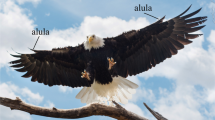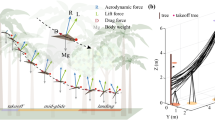Abstract
We tested a mechanical model of wing, which was constructed using the measurements of wingspan and wing area taken from three species of gliding birds. In this model, we estimated the taper factors of the wings for jackdaw (Corrus monedula), Harris’ hawk (Parabuteo unicinctas) and Lagger falcon (Falco jugger) as 1.8, 1.5 and 1.8, respectively. Likewise, by using the data linear regression and curve estimation method, as well as estimating the taper factors and the angle between the humerus and the body, we calculated the relationship between wingspan, wing area and the speed necessary to meet the aerodynamic requirements of sustained flight. In addition, we calculated the relationship between the speed, wing area and wingspan for a specific angle between the humerus and the body over the range of stall speed to maximum speed of gliding flight. We then compared the results for these three species of gliding birds. These comparisons suggest that the aerodynamic characteristics of Harris’ hawk wings are similar to those of the falcon but different from those of the jackdaw. This paper also presents two single equations to estimate the minimum angle between the humerus and the body as well as the minimum span ratio of a bird in gliding flight.
Similar content being viewed by others
Abbreviations
- β:
-
angle between humerus and body
- β min :
-
minimum angle between humerus and body
- β e :
-
empirical span ratio ( b obs/b max )
- β min sr :
-
minimum span ratio
- b:
-
wing span
- bB :
-
body width
- bmax :
-
maximum wing span
- bobs :
-
observed wingspan
- c:
-
wing chord
- C l,max :
-
maximum lift coefficient
- e:
-
taper factor
- g:
-
acceleration due to gravity
- k:
-
proportionality constant, b B = Kb max
- l:
-
length
- m:
-
body mass
- Re:
-
Reynolds number
- S:
-
wing area
- S′:
-
wing area lost owing to flexing
- r 1, r 2, r 3 :
-
length of wing elements
- S max :
-
maximum wing area
- Vmin :
-
stall speed
- U ∞ :
-
velocity of the fluid relative to the moving object
- v:
-
kinematic viscosity
- ϑ:
-
angle
- ρ:
-
air density
References
Hedenstrom A 1993 Migration by soaring or flapping flight in birds: the relative importance of flight cost and speed; Phil. Trans. R. Soc. Lond. B 342 353–361
Hankin E H 1913 Animal flight: a record of observation (London: Iliffe)
Pennycuick C J 1968 A wind-tunnel study of gliding flight in the pigeon Columbalivia; J. Exp. Biol. 49 509–526
Rosen M and Hedenstrom A 2001 Gliding flight in a jackdaw: a wind tunnel study; Exp. Biol. 204 1153–1166
Spedding G R 1987 The wake of a kestrel Falco tinnunculus in gliding flight; J. Exp. Biol. 127 45–57
Tucker V A 1987 Gliding birds: the effect of variable wingspan; J. Exp. Biol. 133 33–58
Tucker V A and Heine C 1990 Aerodynamic of gliding flight in a Harris’ hawk, Parabuteo unicinctus; J. Exp. Biol. 149 469–489
Tucker V A and Parrot G C 1970 Aerodynamic of gliding flight in a falcon and other birds; J. Exp. Biol. 52 345–367
Tucker V A 1988 Gliding birds: descending flight of the white-backed vulture, Gyps africanus; J. Exp. Biol. 140 325–344
Tucker V A, Cade T J and Tucker A E 1998 Dividing speeds and angles of a gyrfalcon (Falco rusticolus); J. Exp. Biol. 201 2061–2070
Von Mises R 1945 Theory of flight (New York: McGraw-Hill)
Withers P C 1981 The aerodynamic performance of the wing in red-shouldered hawk Buteo laneaeis and a possible areoelastic role of wing-tip slots; Ibis 123 239–247
Parrott C G 1970 Aerodynamic of gliding flight of black vulture Coragyps atratus; J. Exp. Biol. 53 363–374
Spaar R and Bruderer B 1996 Soaring migration of steppe eagles Aquila nipalensis in southern Israel: flight behaviour under various wind and thermal conditions; J. Avian Biol. 27 289–301
Author information
Authors and Affiliations
Corresponding author
Rights and permissions
About this article
Cite this article
Zahedi, M.S., Khan, M.Y.A. A mechanical model of wing and theoretical estimate of taper factor for three gliding birds. J Biosci 32, 351–361 (2007). https://doi.org/10.1007/s12038-007-0034-z
Received:
Accepted:
Published:
Issue Date:
DOI: https://doi.org/10.1007/s12038-007-0034-z




